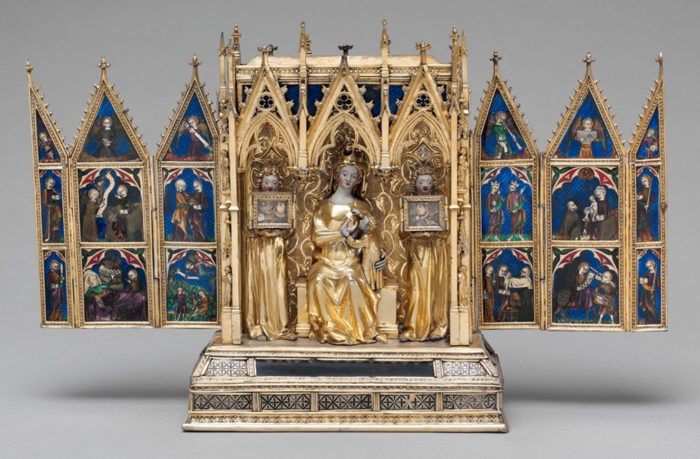14
11
.23
Introducing Hybrid Relics
We are excited to announce the start of Hybrid Relics, a Horizon Agile Round 3 project which is focussing on musical instruments, secular and religious relics as a way to start to explore new and innovative ways to think about social computing and designing hybrid products. Things that exist as both physical and digital. We’re starting to work out how we might deal with what we’re calling hybridity using a range of different design approaches.
For lots of people the term ‘relic’ perhaps had negative connotations, we’ve all talked about relics as things that are a bit dusty and perhaps reminiscent of a bygone age, but there are also other meanings, such as religious relics, which still play a part in contemporary worship for many people around the world. There are even relic guitars; new instruments that are made to look and feel as though they’re ‘road worn’ or have been played for years. As with many physical items today, they also have a digital presence too, and it’s this that we’d like to explore and experiment with.
One of our first activities has been to set up a project website which gives an overview the project and lists the project team, thus far consisting of 4 researchers, from different disciplines and with very different interests: Dr Emma McClaughlin, Dr Laurence Cliffe, Dr Glenn McGarry and Dr Richard Ramchurn.
Emma is looking into the how the term ‘Relic’ has been used in written documents throughout the ages. This will give us some understandings about the meaning of the term, and taking our more experimental design approaches, acts as a way for the team to reflect on the physical uses of relics over time.
Laurence is examining different ways that we might engage with physical artefacts using audio. We’re really keen to think about the senses and the role that these play in relation to our engagement with physical objects.
Glenn and I have been working to prepare an ethics application covering research activities focussing on the three areas of Musical instruments, Religious and Secular Relics. We hope to hear back from the Ethics Committee shortly.
Richard is starting this month and has a lot of experience in developing creative content. We are thinking about how to use 3D objects in this space and how they might relate to contemporary art. Perhaps we might even develop some sort of digital reliquary. A reliquary is an object where religious relics are often kept. On a recent visit to Stonyhurst Museum I saw some amazing reliquaries and got to speak to Dr Jan Graffius, who is an expert in the area.

Reliquary Shrine – Attributed to Jean de Touyl French ca. 1325–50 https://creativecommons.org/publicdomain/zero/1.0/deed.en
Developing the Network
Another key activity has been to start developing a network with academics from the School of Law. As the network develops, we envisage interesting and perhaps unforeseen connections between people and projects. Dr De Wilde (Principal Investigator of the AHRC funded Anglo Norman Dictionary one of our partners at Aberystwyth University) and I have started to write about the nature of text and history. This will act as a catalyst to provoke other members to think about the nature of Hybrid Relics. Interestingly the project has started to provoke discussions with School of Law (Notts) about their interest too, linking to history, language, privacy and faith; with Dr Sarah White and Dr Will Eves (Directors of the History of Law and Governance Centre) both joining the project and affiliating the centre to the project. Dr Oliver Butler who leads the Nottingham Law and Technology Group at Nottingham also joining the project. Oliver and I have had some great discussions about digital privacy, personal beliefs and VR/3D Relics. It’s also been fascinating to discuss some of the historical literature relating to relics with Dr Claire Taylor in the Department of History at Nottingham, in interdisciplinary projects such as this. It’s really refreshing to get a genuinely different perspective on the research area that you’re working in. I always look forward to hearing Claire talk about her area of scholarship, it makes you reflect and having medieval resources as a catalyst for digital design is something that we fully intend to explore.
What Next?
It’s been a really busy month, but we’re starting to pull together some digital resources that we can use to support people and groups that we want to work with to co-design and develop our ideas. I think that this is a responsible thing to do, being able to engage with people is important and it helps you to understand where people are coming from and the way they want to get involved in design.
On a more technical note Professor Chris Greenhalgh and I have been batting some ideas backwards and forwards. It’s always good to work with colleagues who enjoy this, and Prof Alan Dix (Swansea Uni and Cardiff Met) and I have had some really good discussions about Digital Crafting.
I’ll leave it at that at the moment, but even within the first few weeks it’s been really interesting to start to talk to people and see ideas and concepts emerge. We’ve got a few more things bubbling away, but I don’t want to give too much away right now!
written by Alan Chamberlain, PI
Tags:
Anglo Norman Dictionary,
design,
hybrid,
relics,
reliquary,
Stonyhurst Museum














